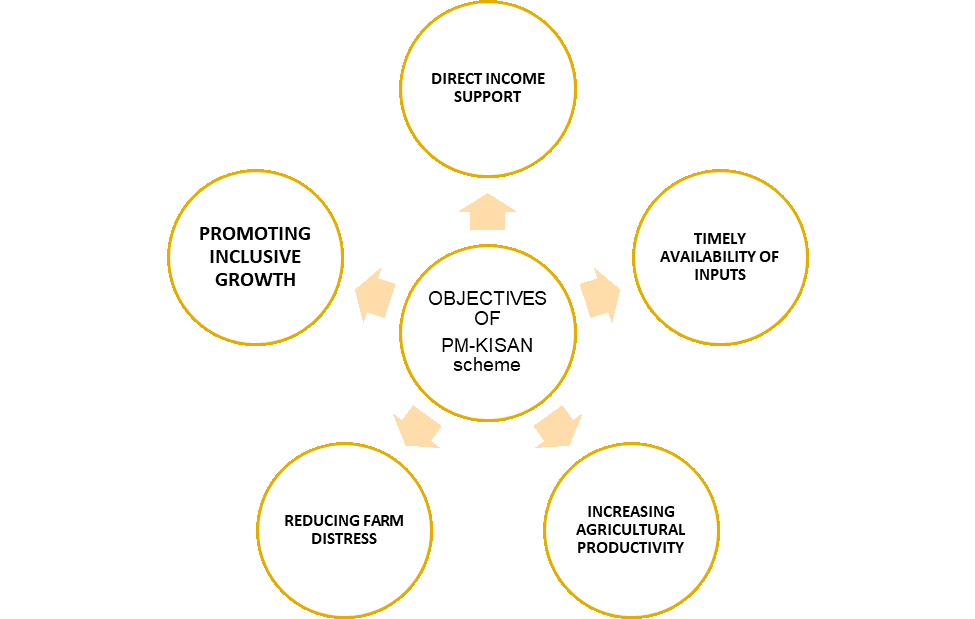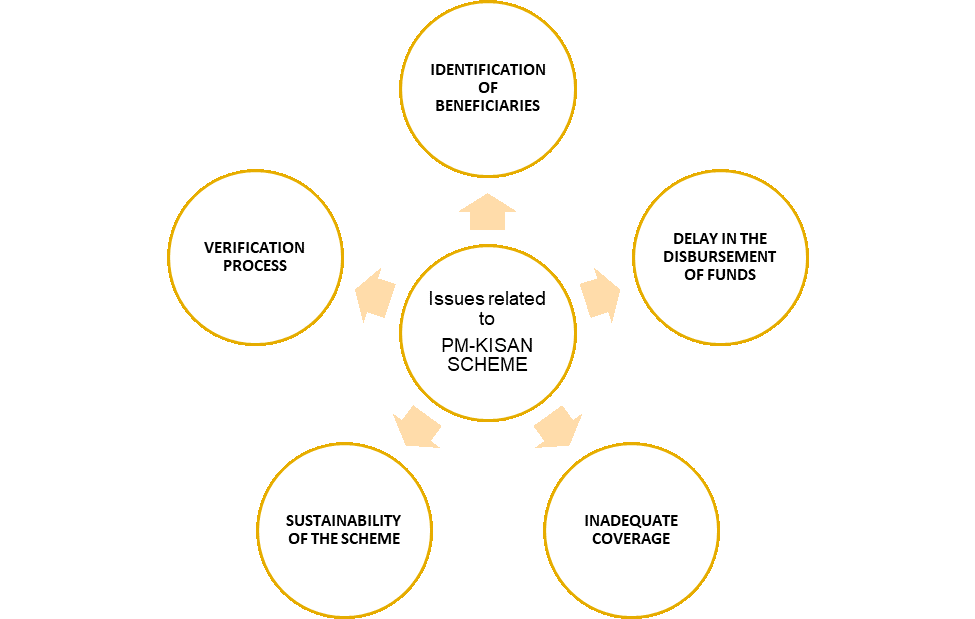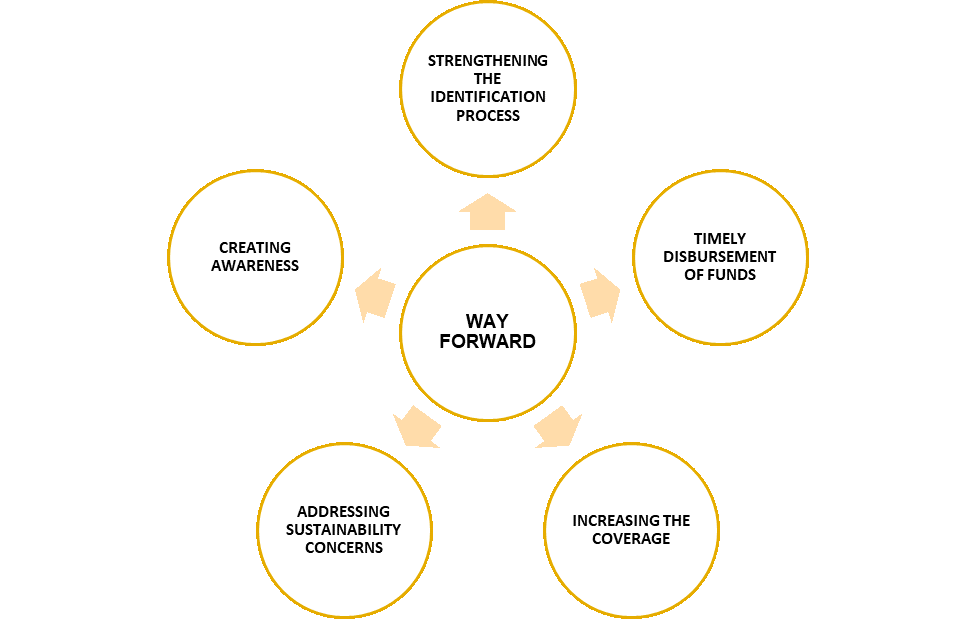08 Apr 2023 PM KISAN (Pradhan Mantri Kisan Samman Nidhi)
PM KISAN (Pradhan Mantri Kisan Samman Nidhi)
This article covers “Daily Current Affairs” and the topic details the PM KISAN scheme. The topic is important about how government support is needed because farmers are facing an agrarian crisis. Erroneous monsoons, non-remunerative incomes, and fragmented land holdings are some causes of agrarian distress.

Pradhan Mantri Kisan Samman Nidhi
For Prelims:
About PM KISAN – Features, and comparison with similar schemes
For Mains: GS 3, Agriculture.
- Scheme Features: Past Performance and future possibilities
- Role of income support measures in Indian agriculture.
- Role of Government Initiatives to augment farmers’ Incomes.
Content of the Article:
- Why in news
- Status of Scheme:
- Objectives of the Scheme
- Origin of the Scheme
- Features of the scheme
- Issues related to the scheme
- Way Forward
Why in news:
Recently, PM released the 13th installment amount amounting to Rs. 16,800 crores to more than 8 crore beneficiary farmers.
Status of PM KISAN scheme
More than 11 crore farmer families, primarily the small and marginal, have received over 2.25 lakh crores of funds through the PM-KISAN initiative. During the Covid lockdown, multiple installments of Rs. 1.75 lakh crores were distributed to support these needy farmers. The Scheme has been beneficial for more than three crore women beneficiaries who have collectively received over Rs. 53,600 crores.
The funds provided through the initiative have spurred rural economic growth, eased credit constraints for farmers, and boosted agricultural investments. It has also led to an increase in farmers’ risk-taking capacity, resulting in more investments. IFPRI has reported that the PM-KISAN funds are helping recipients meet their agricultural needs and other expenses such as education, medical care, and marriage.
Objectives of the PM KISAN Scheme
PM-Kisan is a scheme launched by the Government of India to provide income assistance to farmers across the country. The primary objective of PM-Kisan is to supplement the income of small and marginal farmers and to ensure that they have enough money to meet their agricultural needs and household expenses.

Some of the specific objectives of PM-Kisan are:
- Providing direct income support to farmers: PM-Kisan provides direct support of Rs. 6,000 per year to eligible farmers, which is paid in three equal installments of Rs. 2,000 each.
- Ensuring timely availability of inputs: The scheme aims to ensure the timely availability of agricultural inputs such as seeds, fertilizers, and pesticides, by providing additional funds to farmers.
- Increasing agricultural productivity: By providing financial assistance to farmers, PM-Kisan aims to increase agricultural productivity and improve the overall economic condition of farmers.
- Reducing farm distress: The scheme seeks to reduce farm distress and alleviate the financial burden on farmers, thereby reducing the incidence of farmer suicides.
- Promoting inclusive growth: PM-Kisan aims to promote inclusive growth by ensuring that the benefits of the scheme reach all farmers, especially those who are financially weaker and do not have access to formal credit.
Origin of the PM KISAN
The Ryuthu Bandhu Scheme is a precursor to the PM KISAN scheme. The Government of Telangana started the Ryuthu Bandhu scheme under which it disbursed a certain sum twice a year to augment farmers’ investments in agriculture. The scheme was widely recognized and appreciated for its direct support to farmers.
Building on Ryuthu Bandhu’s success, the Indian Government launched Pradhan Mantri Kisan Samman Nidhi Yojana (PM KISAN) a similar farmer’s investment support scheme to offer financial assistance to farmers nationwide.
While the Rythu Bandhu scheme of Telangana and the PM-Kisan scheme share similarities in their objective of providing direct income support to farmers, they differ in their implementation and scope.
- Eligibility criteria: The eligibility criteria for the two schemes are different. Ryuthu Bandhu is a state-level scheme that is available to all farmers in Telangana, regardless of their landholding size, while PM-KISAN is a central scheme that provides income support to small and marginal farmers all across the country.
- Mode of assistance: Under the Ryuthu Bandhu scheme, farmers receive a fixed amount of money per acre of land that they own, while under PM-KISAN, eligible farmers receive direct cash transfers of Rs. 6000 per annum, payable in three installments.
- Timing of disbursement: The Ryuthu Bandhu scheme provides assistance to farmers before the sowing season, while PM-KISAN provides assistance throughout the year in three installments.
- Funding: While Ryuthu Bandhu is entirely funded by the Telangana state government, PM-KISAN is funded by the central government.
Features of PM-KISAN
Some of the key features of this scheme have been discussed below:
- Income Support: The primary feature of this scheme is the income support it provides to eligible farmers.
- Eligibility Criteria: All landholding farmer households in the country are eligible under PM KISAN but they are subject to certain exclusion criteria.
- Direct Transfer: The scheme provides direct benefit transfer (DBT) to the farmers’ bank accounts. The funds are transferred in three installments of Rs. 2000 each, every four months.
- Central Sector Scheme: The funds for the scheme are allocated to the states and Union Territories by the Central Government.
- Role of States: The state governments are responsible for identifying the eligible beneficiaries and transferring the funds to their bank accounts.
- Monitoring and Evaluation: The scheme is monitored and evaluated by the Ministry of Agriculture and Farmers’ Welfare. A Grievance Redressal Mechanism has also been established to address any issues faced by the farmers.
Issues related to the PM KISAN
Undoubtedly, the PM-KISAN scheme has been successful in providing financial support to farmers and their families, but there are some issues related to the scheme that has been identified.

- Identification of beneficiaries: There have been reports of errors in the beneficiary list, with some eligible farmers being excluded, while others who do not meet the eligibility criteria have received the benefits. This has resulted in a lack of transparency and accountability in the selection process.
- Delay in the disbursement of funds: Some farmers have reported that they have not received the funds on time, which has affected their ability to invest in their crops and purchase necessary inputs. This delay can be attributed to various factors such as inadequate infrastructure, technical glitches, and bureaucratic procedures.
- Inadequate coverage: The scheme’s coverage is limited to small and marginal farmers, and the support provided may not be sufficient to address the challenges faced by larger farmers. This has resulted in some farmers being left out of the scheme’s ambit.
- Sustainability of the scheme: The PM-KISAN scheme provides income support to farmers, but it does not address the structural issues that affect agriculture, such as low productivity, inadequate infrastructure, and lack of access to credit.
- Verification process: Some farmers have reported that the verification process to avail of the benefits under the scheme is cumbersome and time-consuming, which has discouraged many eligible farmers from applying.
Way Forward
PM KISAN has been a great initiative to provide timely income support to farmers, This enables them to purchase inputs through the money disbursal thrice a year. To ensure the effectiveness and sustainability of the PM-KISAN scheme, the following steps can be taken:

Details on the PM-KISAN scheme
- Strengthening the identification process: The government should take steps to strengthen the identification process to ensure that all eligible farmers are included in the scheme. This can be done through the use of technology such as satellite imagery and Aadhaar-based verification.
- Timely disbursement of funds: The government should ensure that the funds are disbursed on time to avoid delays that affect farmers’ ability to invest in their crops and purchase necessary inputs.
- Increasing the coverage: The scheme’s coverage can be expanded to include more farmers and provide them with sufficient support to meet their needs.
- Addressing sustainability concerns: The government should take steps to address the structural issues that affect agriculture, such as low productivity, inadequate infrastructure, and lack of access to credit. This can be done through measures such as investing in agriculture research, improving irrigation facilities, and providing credit to farmers.
- Creating awareness: The government should create awareness about the scheme among farmers to ensure that all eligible farmers apply for and receive the benefits.
- Regular monitoring and evaluation: Regular monitoring and evaluation of the scheme can help identify gaps and areas for improvement, leading to better implementation of the scheme.
In conclusion, the PM-KISAN scheme has the potential to provide much-needed support to farmers and their families. By addressing the concerns and taking the necessary steps, the government can ensure the scheme’s effectiveness and sustainability in the long run.
Source:
Get Daily Current Affairs from Plutus IAS


No Comments